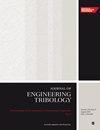Influence of the metal coating on nano-cutting process of cubic silicon carbide
IF 1.8
3区 工程技术
Q3 ENGINEERING, MECHANICAL
Proceedings of the Institution of Mechanical Engineers, Part J: Journal of Engineering Tribology
Pub Date : 2023-10-12
DOI:10.1177/13506501231204652
引用次数: 0
Abstract
The effect of the metal coating on the machinability of cubic silicon carbide was investigated by molecular dynamics simulation. The effect of the metal coating on the surface of the workpiece was explained using cutting force, friction coefficient, surface morphology, stress, temperature, and tool wear. The results show that the influence of metal type on cutting force, surface morphology, and stress is insignificant for coating thickness. However, the model with Cu coating has a tool suspension key number of 400 at the maximum cutting distance. The number of tool suspension keys for the Ni-Ti coating model is around 1700, indicating that the type of coating has a significant impact on tool wear. Furthermore, the results also show that in the three metals of Cu, Ni and Ni -Ti, Cu coating has the greatest impact on improving cutting performance. Among them, the average cutting force of 1.5 nm Cu coating is about 33.3% lower than that of without coating, and the tool wear is about 26.7% lower. These results demonstrate the effects of the metal coating on the workpiece surface from a theoretical point of view.金属涂层对立方碳化硅纳米切削过程的影响
采用分子动力学模拟方法研究了金属涂层对立方碳化硅切削性能的影响。从切削力、摩擦系数、表面形貌、应力、温度和刀具磨损等方面解释了金属涂层对工件表面的影响。结果表明,金属类型对切削力、表面形貌和应力的影响对涂层厚度的影响不显著。而Cu涂层模型在最大切削距离下,刀具悬浮键数为400。Ni-Ti涂层型号的刀具悬架键数在1700个左右,说明涂层类型对刀具磨损有显著影响。此外,结果还表明,在Cu、Ni和Ni -Ti三种金属中,Cu涂层对提高切削性能的影响最大。其中,1.5 nm Cu涂层比未涂层的平均切削力降低约33.3%,刀具磨损降低约26.7%。这些结果从理论的角度证明了金属涂层对工件表面的影响。
本文章由计算机程序翻译,如有差异,请以英文原文为准。
求助全文
约1分钟内获得全文
求助全文
来源期刊

CiteScore
4.20
自引率
5.00%
发文量
110
审稿时长
6.1 months
期刊介绍:
The Journal of Engineering Tribology publishes high-quality, peer-reviewed papers from academia and industry worldwide on the engineering science associated with tribology and its applications.
"I am proud to say that I have been part of the tribology research community for almost 20 years. That community has always seemed to me to be highly active, progressive, and closely knit. The conferences are well attended and are characterised by a warmth and friendliness that transcends national boundaries. I see Part J as being an important part of that community, giving us an outlet to publish and promote our scholarly activities. I very much look forward to my term of office as editor of your Journal. I hope you will continue to submit papers, help out with reviewing, and most importantly to read and talk about the work you will find there." Professor Rob Dwyer-Joyce, Sheffield University, UK
This journal is a member of the Committee on Publication Ethics (COPE).
 求助内容:
求助内容: 应助结果提醒方式:
应助结果提醒方式:


